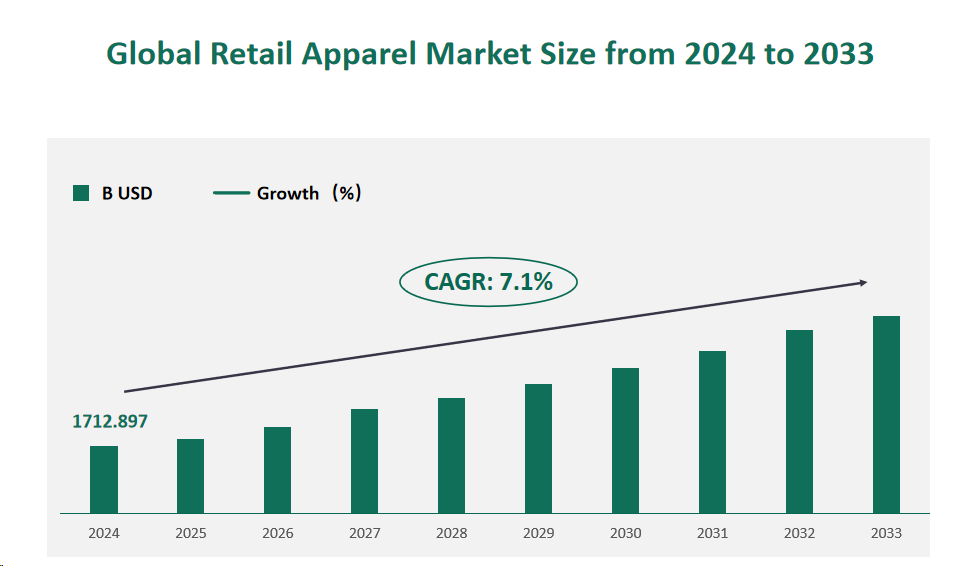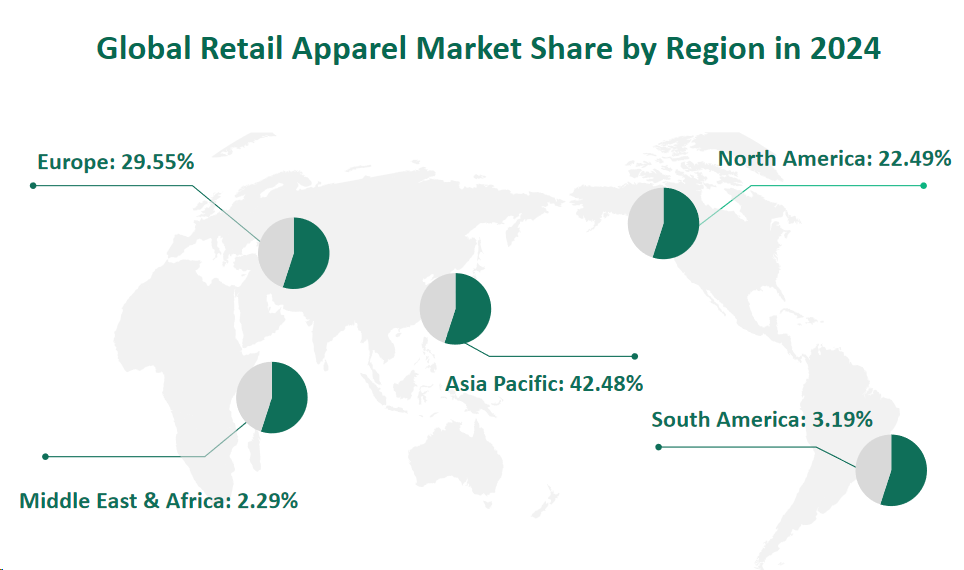1 Global Retail Apparel Market Size (Value) and CAGR (2024-2033)
The global Retail Apparel market is on the cusp of significant growth, with the total value projected to reach approximately $1.71 trillion in 2024. This market is anticipated to grow at a Compound Annual Growth Rate (CAGR) of 7.1% from 2024 to 2033.
Retail apparel is defined as the business of selling clothing and fashion items to consumers through multiple retail channels. This sector is characterized by its diversity, offering a broad range of products that cater to different consumer preferences and needs.
The retail apparel sector, which encompasses a wide array of products including tops, dresses, bottoms, and other fashion items, is sold through various retail channels, both physical and online, and has become a cornerstone of the global fashion industry.
Figure Global Retail Apparel Market Size (B USD) and CAGR 2024-2033

2 Drivers and Key Trends in the Retail Apparel Market
Sustainability has become a cornerstone of the retail apparel market, with an increasing number of consumers seeking out eco-friendly and ethically produced clothing. This shift towards greener practices is driving companies to adopt sustainable materials, reduce waste, and promote circular fashion models. The demand for transparency in supply chains is also on the rise, with consumers expecting brands to be accountable for their environmental and social impacts.
Digital transformation is another significant trend, with e-commerce becoming a dominant force in the retail apparel industry. Technologies such as artificial intelligence, virtual fitting rooms, and augmented reality are being integrated to enhance the online shopping experience and provide personalized recommendations to customers.
Personalization is gaining traction as consumers seek unique clothing that reflects their individual style. Data analytics and customer insights are being leveraged to offer customized products and services, allowing retailers to stand out in a crowded market. This trend is driven by the desire for exclusive and tailored experiences, which is particularly pronounced among younger demographics.
Globalization has facilitated cross-border trade, allowing retailers to source materials and manufacture products in the most cost-effective locations while selling to a global customer base. This has led to increased competition and the need for retailers to differentiate themselves through branding, quality, and unique value propositions.
3 Challenges and Restraints in the Retail Apparel Market
Despite the promising outlook, the retail apparel market faces several challenges. The complexity of supply chains, with the need for flexibility and responsiveness to unpredictable fashion trends, poses a significant hurdle. Fierce competition, especially with the rise of online platforms and global brands, requires retailers to differentiate themselves through brand marketing, design, and procurement.
Rapidly changing consumer preferences, driven by factors such as fashion trends, sustainability, and quality demands, necessitate quick adaptation from retailers to maintain market share. Regulatory issues and the need to comply with various international standards also add layers of complexity to the industry.
4 Global Retail Apparel Market Size and Share by Type in 2024
Looking at the segmented market by type in 2024, tops are expected to dominate with a forecasted market size of $642.84 billion, reflecting their significant share in the retail apparel industry. This is attributed to the versatility and high demand for tops across various consumer segments.
Dresses follow with a projected market size of $240.32 billion, highlighting their enduring popularity, especially with the growing focus on formal and casual events.
Bottoms are also expected to capture a substantial market share, with a forecasted value of $553.66 billion, due to the consistent demand for jeans, trousers, and other bottom wear.
Other categories, including suits and pajamas, are anticipated to contribute $276.07 billion to the market. These figures underscore the diversity of the retail apparel market and the varying growth trajectories of different product types.
The fastest-growing segment is expected to be dresses, with a CAGR that outpaces the overall market, driven by trends in fashion and the increasing demand for specialty clothing.
Table Global Retail Apparel Market Size and Share by Type in 2024
Type | Market Size (B USD) 2024 | Market Share 2024 |
Top | 642.84 | 37.53% |
Dresses | 240.32 | 14.03% |
Bottoms | 553.66 | 32.32% |
Others | 276.07 | 16.12% |
5 Global Retail Apparel Market Size and Share by Application in 2024
The Retail Apparel market is segmented by application into Men, Women, and Kids wear, each playing a crucial role in the industry’s expansion. In 2024, the market size for Men’s apparel is projected to be $544.27 billion, reflecting the growing demand for menswear and its evolving trends.
Women’s wear, being the largest segment, is expected to reach $890.13 billion, indicating the predominant share of women’s fashion in the retail apparel market. This is attributed to the constant innovation in women’s fashion and the influence of trends and seasonal changes.
Kids’ wear is also expected to hold a significant position with a market size of $278.49 billion, highlighting the importance of children’s fashion and the parents’ willingness to invest in quality clothing for their children.
Table Global Retail Apparel Market Size and Share by Application in 2024
Application |
|
|
Men | 544.27 | 31.77% |
Women | 890.13 | 51.97% |
Kids | 278.49 | 16.26% |
6 Global Retail Apparel Market Size and Share by Region in 2024
The Asia-Pacific region emerges as the largest market for Retail Apparel, with an impressive projected value of $727.65 billion in 2024. This region’s dominance can be attributed to several factors, including a burgeoning middle class, a rapidly expanding youth population, and a growing demand for fashionable and branded apparel.
Countries like China and India are pivotal, with their large consumer bases and increasing disposable incomes fueling the market’s growth. The region’s diversity also allows for a wide range of fashion expressions, from traditional attire to modern, urban styles.
The growth in the Asia-Pacific region is not only in terms of quantity but also in terms of quality and sustainability. Consumers are becoming more conscious of the environmental impact of the fashion industry, leading to a rise in demand for eco-friendly and ethically sourced clothing. This shift has prompted retailers to adopt more sustainable practices, from using organic materials to implementing circular fashion models.
While the Asia-Pacific region leads in market size, North America is projected to experience the fastest growth, with a market size of $385.30 billion in 2024. The region’s maturity and the presence of well-established fashion markets contribute to this growth. The United States, in particular, is a key driver, with its strong economy and consumer preference for high-quality, trendy apparel. The North American market is also characterized by a high level of brand loyalty and a strong preference for online shopping, which has been further accelerated by the pandemic.
Europe, with a market size of $506.19 billion, holds the second position and is known for its fashion-forward consumers and established fashion houses. The region is also a hub for luxury apparel and is increasingly focusing on sustainable fashion practices.
South America, with a market size of $54.60 billion, is seeing growth, particularly in countries like Brazil, which is leading the region’s fashion industry with its vibrant styles and growing middle class.
The Middle East and Africa, with a market size of $39.17 billion, are regions with significant potential for growth.
Figure Global Retail Apparel Market Share by Region in 2024

7 Top 3 Companies in the Global Retail Apparel Market
7.1 Amazon
Amazon, established in 1994 and headquartered in the USA, is a titan in the e-commerce industry with a global reach. The company’s retail apparel segment is a significant part of its diverse product offerings, which include electronics, toys, and home goods, in addition to apparel.
Amazon’s business model revolves around providing a vast selection of products through its online platform, with a strong emphasis on customer service and convenience.
Amazon offers a comprehensive range of apparel, from casual wear to formal attire, and from sportswear to luxury fashion, catering to a wide demographic.
In 2023, Amazon reported revenues of $54.1 billion from its retail apparel segment, with a gross margin of 43.39%. In 2024, the company’s revenues increased to $58.47 billion, and the gross margin reached 41.62%.
7.2 Inditex (ZARA)
Inditex, the parent company of ZARA, was established in 1985 and is based in Spain. It is renowned for its fast-fashion model, which allows it to quickly respond to changing fashion trends. Inditex operates multiple brands, including Zara, Bershka, and Pull&Bear, among others.
Inditex has a strong focus on design, production, and retail, with a vertically integrated model that enables it to maintain control over its supply chain.
The company offers a wide array of clothing and accessories for men, women, and children, with a particular emphasis on fashion-forward designs and sustainable materials.
In 2023, Inditex recorded revenues of $35.95 billion, with a gross margin of 56.83%. By 2024, revenues grew to $37.57 billion, with a gross margin of 55.49%.
7.3 Shein
Shein, founded in 2008 and headquartered in Singapore, has rapidly become a major player in the global fast-fashion market. The company specializes in women’s fashion but has expanded to include men’s and children’s clothing, as well as home decor and accessories.
Shein’s success is attributed to its agile supply chain, which allows for rapid production and turnover of trendy items at affordable prices.
Shein offers a vast selection of fashion items, from the latest runway-inspired pieces to basic essentials, targeting the fashion-conscious consumer who values style and value.
In 2023, Shein achieved revenues of $24.05 billion, with a gross margin of 42.69%. By 2024, the company’s revenues climbed to $30.84 billion, with a gross margin of 42.14%.





